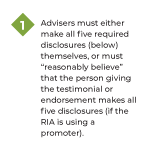In the United States, Registered Investment Advisers (RIAs) are required to register in one of 2 ways: with the Federal government (namely the SEC) or with one or more state securities regulatory agencies. While SEC-registered RIAs are governed by the Investment Advisers Act of 1940 (and its associated regulations), state-registered RIAs are subject to the individual rules of the states (which have their own securities laws and regulations) where they are registered. So RIAs not only face a different set of regulations depending on whether they are Federally or state-registered, but state-registered RIAs, in particular, can also face a widely varying set of rules depending on which state they are registered in.
In this guest post, Chris Stanley, investment management attorney and Founding Principal of Beach Street Legal, breaks down some of the key differences between Federal and state registration, including who needs to register as an RIA, when an RIA can (or must) register with the SEC versus state authorities (including notice filings and unique state circumstances for RIAs with clients in certain states), and registration requirements for RIA firms’ Investment Adviser Representatives (IARs) at the Federal and state levels.
One of the first determinations an RIA owner must make is whether they must register with the SEC or state authorities, and if the latter, which state (or states) they must register with. In general, unless they meet one of a handful of qualifications for an exception (most commonly by having over $100 million in AUM or being registered in 15 or more states), RIAs must register at the state level. State-registered RIAs usually must register in the state(s) where they have a place of business, plus any state where they have more than a ‘de minimis’ number of clients (usually 5) – though notably, Louisiana requires registration from every state-registered RIA with clients in state, regardless of the number, and Texas requires state-registered RIAs to ‘notice file’ if they have less than the de minimis threshold. Several other states additionally require notice filings from SEC-registered advisors with clients in those states, meaning that even for SEC-registered RIAs, staying compliant with filing requirements requires them to understand the filing rules for each state in which the firm does business.
When it comes to the individual IARs employed by advisory firms, the registration requirements also fall along Federal and state lines. State-registered firms generally must have at least one IAR registered in each state where the firm itself is registered, and SEC-registered firms need only register IARs who work with a certain number of clients. The key difference between firm and IAR registration is that, regardless of whether the RIA firm is Federally or state-registered, IARs always register at the state level.
Ultimately, the key point is that the idiosyncrasies between state registration and filing requirements for firms and individuals warrant paying close attention to the rules of each state in which an RIA does business, regardless of whether the firm is Federally or state-registered. This is particularly relevant not only for startup firms but also for those that are expanding or adding clients in new states via new virtual meeting capabilities. By more deeply understanding the nuances of Federal and state filing rules, advisers can be better positioned to stay compliant while managing their changing circumstances!






 Welcome back to the 189th episode of Financial Advisor Success Podcast!
Welcome back to the 189th episode of Financial Advisor Success Podcast!


